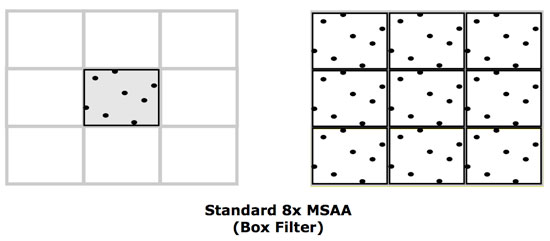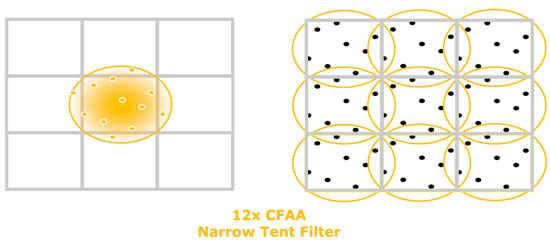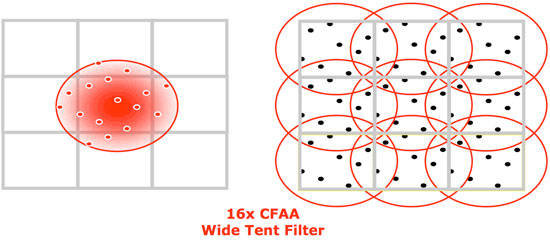ATI Radeon HD 2900 XT: Calling a Spade a Spade
by Derek Wilson on May 14, 2007 12:04 PM EST- Posted in
- GPUs
CFAA and No Fixed Resolve Hardware
That's right, R600 doesn't have hardware dedicated to resolving MSAA in the render back end - the only MSAA related tasks handled in the render back end are compression and evaluation of the subpixels. All antialiasing resolve is performed on the shader hardware. Certainly, AMD would prefer we start by telling you about the neat custom resolve filters that can be implemented on their shader hardware, but we would rather speculate about this for a moment first.
AMD has stated that, moving forward, in addition to allowing programmable sample patterns, future DX versions may allow for custom resolve filters as well. This is cited as one of the reasons why R600 uses shader hardware to resolve AA samples. AMD has given us a couple different resolve filters to play with, which we'll talk about in a minute. But at a point where we're seeing the first DX10 hardware from graphics makers, and at a time where competitive performance is paramount, it doesn't seem like the decision we would have made.
Whatever the circumstances, R600 sends its pixels back up from the render back ends to the shader hardware to combine subpixel data into a final pixel color. In addition to the traditional "box" filter (which uses subpixels within the area of a single pixel), the new driver offers the ability to use subpixel data from neighboring pixels resolved with a tent filter (where the impact of the subpixels on final color is weighted by distance). AMD calls this CFAA for custom filter antialiasing.

AMD currently offers narrow and wide tent filters which can be implemented using 2, 4, or 8 multisamples per pixel boundary. This gives us nine different AA options including traditional box filters. More filter options can be provided via driver updates, as these are essentially driver managed shader programs. Here's the breakdown of the options based on the type of filter and the number of samples used to resolve each pixel.



One of the useful side effects of these tent filters is that they are also capable of antialiasing interior pixels, not just those covered by more than one triangle. This is helpful in getting rid of aliasing in textures which can occur in certain cases.
While tent filters are a very interesting idea to improve antialiasing, they are not without their drawbacks. First, it is possible for tent filters, even though neighboring subpixel data is weighted less than internal subpixels, to create a muddy look, especially with high contrast fine detail like thin text for example. While tent filters can antialias textures on interior pixels, they can also create a blur effect where it isn't needed which removes detail from the scene.
Edge Detection
While tent filters are good in the general edge case, in order to be really compelling from an image quality stand point, AMD decided to go a step further and adaptively apply more AA in places where it would do the most good and less elsewhere. This will be done by applying an edge detect algorithm to the framebuffer and using more aggressive AA on these edges.
We learned that edge detection can be sped up by looking at pixel compression. If all the subpixels for one fragment are the same color, compression will be at its highest and there is no edge within that pixel. Beyond using this information, we are told that the algorithm uses straightforward derivative computations to find high frequency data (high contrast edges) much the same way Photoshop does.
The combination of edge detection and tent filters gives us two extra option beyond the ones listed above: 12x narrow tent filter with edge detect and 24x wide tent filter with edge detect. These filters are capable of very good image quality, though this quality does come at a performance cost. We will take a look at performance and image quality after we finish going through R600 hardware.










86 Comments
View All Comments
Roy2001 - Tuesday, May 15, 2007 - link
The reason is, you have to pay extra $ for a power supply. No, most probably your old PSU won't have enough milk for this baby. I will stick with nVidia in future. My 2 cents.Chaser - Tuesday, May 15, 2007 - link
Such a revealing tech article. Thanks for other sources Tom.
archcommus - Tuesday, May 15, 2007 - link
$300 is the exact price point I shoot for when buying a video card, so that pretty much eliminates AMD right off the bat for me right now. I want to spend more than $200 but $400 is too much. I'm sure they'll fill this void eventually, and how that card will stack up against an 8800 GTS 320 MB is what I'm interested in.H4n53n - Tuesday, May 15, 2007 - link
Interesting enough in some other websites it wins from 8800 gtx in most games,especially the newer ones and comparing the price i would say it's a good deal?I think it's just driver problems,ati has been known for not having a very good driver compared to nvidia but when they fixed it then it'll windragonsqrrl - Thursday, August 25, 2011 - link
lol...fail. In retrospect it's really easy to pick out the EPIC ATI fanboys now.Affectionate-Bed-980 - Tuesday, May 15, 2007 - link
I skimmed this article because I have a final. ATI can't hold a candle to NV at the moment it seems. Now while the 2900XT might have good value, I am correct in saying that ATI has lost the performance crown by a buttload (not even like X1800 vs 7800) but like they're totally slaughtered right?Now I won't go and comment about how the 2900 stacks up against competition in the same price range, but it seems that GTSes can be acquired for cheap.
Did ATI flop big here?
vailr - Monday, May 14, 2007 - link
I'd rather use a mid-range older card that "only" uses ~100 Watts (or less) than pay ~$400 for a card that requires 300 Watts to run. Doesn't AMD care about "Global Warming"?Al Gore would be amazed, alarmed, and astounded !!
Deusfaux - Monday, May 14, 2007 - link
No they dont and that's why the 2600 and 2400 don't existochentay4 - Monday, May 14, 2007 - link
Let me start with this: i always had a nvidia card. ALWAYS.Faster is NOT ALWAYS better. For the most part this is true, for me, it was. One year ago I boght a MSI7600GT. Seemed the best bang for the buck. Since I bought it, I had problems with TVout detection, TVout wrong aspect ratios, broken LCD scaling, lot of game problems, inexistent support (nv forum is a joke) and UNIFIED DRIVER ARQUITECTURE. What a terrible lie! The latest official drivers is 6 months ago!!!
Im really demanding, but i payed enough to demand a 100% working product. Now ATi latest offering has: AVIVO, FULL VIDEO ACC, MONTHLY DRIVER UPDATES, ALL BUGS I NOTICED WITH NVIDIA CARD FIXED, HDMI AND PRICE. I prefer that than a simple product, specially for the money they cost!
I will never buy a nvidia card again. I'm definitely looking forward ATis offering (after the joke that is/was 8600GT/GTS).
Enough rant.
Am I wrong?
Roy2001 - Tuesday, May 15, 2007 - link
Yeah, you are wrong. Spend $400 on a 2900XT and then $150 on a PSU.